Instruments
The Telescope
The ISO scientific payload consisted of four instruments: a camera (ISOCAM); an imaging photopolarimeter (ISOPHOT); a long wavelength spectrometer (LWS); and a short wavelength spectrometer (SWS). Each instrument was built by an international consortium of scientific institutes and industry, headed by a Principal Investigator (PI), using national funding. Although developed separately, the four instruments were designed to form a complete, complementary and versatile common-user package.
The total payload provided photometric, imaging and polari-metric capabilities at various spectral and spatial resolutions from 2.5 to 240 μm, and spectroscopic capabilities at medium and high resolutions from 2.5 to 195 μm. The instruments were mounted behind the primary mirror. Each one occupied an 80 degree segment of the cylindrical volume available. The 20 arc minute total unvignetted field of view of the telescope was distributed radially to the four instruments by a pyramid mirror. Each experiment received a 3 arc minute unvignetted field, centred on an axis at an angle of 8.5 arc minutes to the main optical axis, therefore the instruments viewed separate areas of the sky. Switching between them involved repointing the satellite. In principle, only one instrument was operational in prime mode at a time.
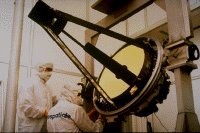 |
|
ISO's telescope component |
ISOCAM
The Infrared Camera (ISOCAM), covering the 2.5-17 μm band with two different detectors. It can be compared to a normal photo camera, taking pictures of the 'infrared face' of astronomical objects at a high resolution (so as to distinguish very fine details).
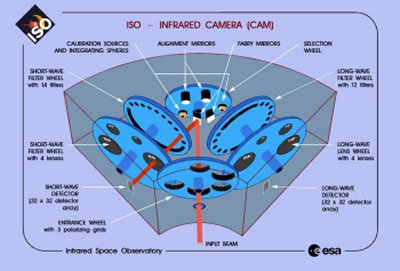 |
|
Diagram of ISOCAM |
ISOPHOT
The photo-polarimeter (ISOPHOT), designed to detect the amount of infrared radiation emitted by an astronomical object. The broad range of wavelengths at which ISOPHOT operated (between 2.5 and 240 μm) allowed it to 'see' objects as cool as the clouds of dust lying among stars and galaxies, whose temperature may be just a few degrees above absolute zero (-273 °C).
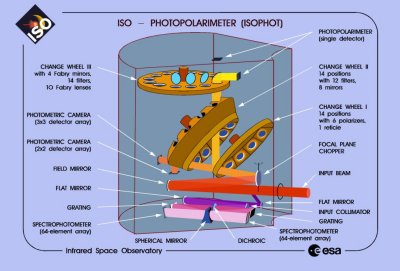 |
|
Diagram of ISOPHOT |
SWS
The Short-Wave Spectrometer (SWS) covered the 2.4 to 45 μm band. It has provided valuable information about the little known chemistry of the Universe, since many molecules emit copiously in the infrared. Moreover, SWS has been able to find out the physical conditions of those chemical constituents, such as temperature or density.
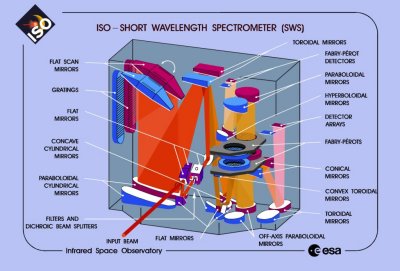 |
|
Diagram of SWS |
LWS
The Long-Wave Spectrometer (LWS) operated at the 45 to 196.8 μm band. LWS has focused on cooler objects than SWS. It is especially useful studying the physical condition in very cold dust clouds in the space between stars.
LWS Principal Investigator: P. E. Clegg, Queen Mary and Westfield College, London, United Kingdom.
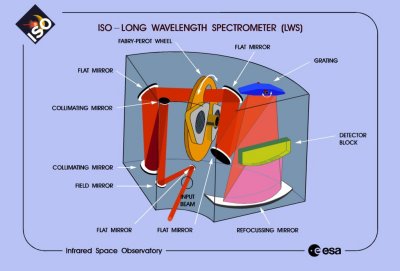 |
|
Diagram of LWS |
